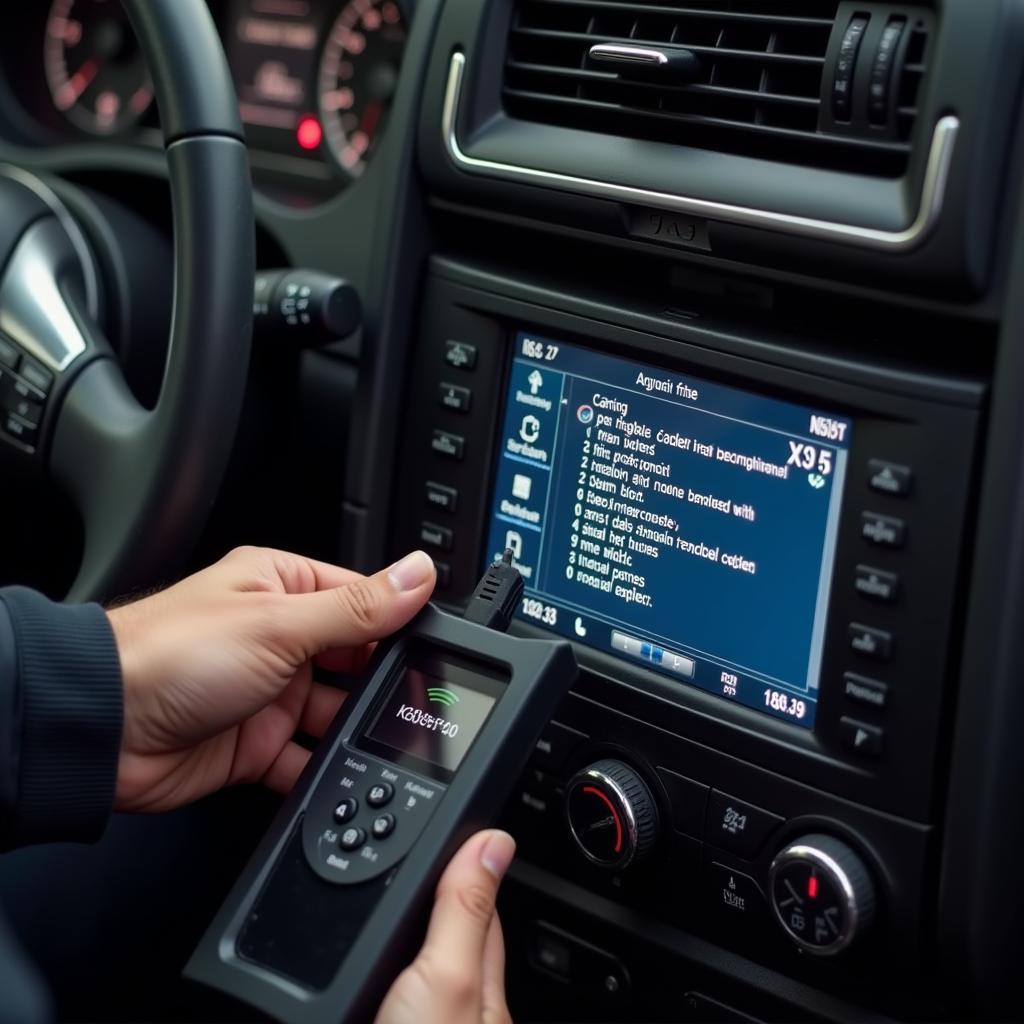Understanding car diagnostic codes is crucial for any car owner or mechanic. These codes, often displayed as a combination of letters and numbers, act as your car’s way of communicating underlying issues. They provide valuable insights into the health of your vehicle, allowing for faster and more accurate diagnosis and repair.
While accessing a Car Diagnostic Codes List Pdf might seem like a quick solution, it’s important to understand the complexities behind these codes and the limitations of static resources.
Delving Deeper into Car Diagnostic Codes
 Car Diagnostic Scanner in Action
Car Diagnostic Scanner in Action
Car diagnostic codes, also known as Diagnostic Trouble Codes (DTCs), are standardized codes that represent specific malfunctions detected in your vehicle’s systems. These codes are generated by your car’s onboard computer system, known as the Engine Control Unit (ECU), when it detects a problem within a sensor, circuit, or system.
DTCs are categorized into different types:
- Powertrain (P Codes): Related to the engine, transmission, and emissions systems.
- Chassis (C Codes): Related to the mechanical components like brakes, steering, and suspension.
- Body (B Codes): Related to body electronics such as power windows, lighting, and airbags.
- Network & Communication (U Codes): Related to issues within the vehicle’s communication network, including modules and sensors.
The Limitations of Car Diagnostic Codes List PDFs
While readily available online, relying solely on car diagnostic codes list PDFs can be misleading and even counterproductive for several reasons:
- Generic Codes: Many PDFs offer generic interpretations of codes, failing to consider the specific make, model, and year of your vehicle. This can lead to misdiagnosis as manufacturers often have their own unique sets of codes.
- Incomplete Information: Static PDFs may not be updated regularly and might lack information on the latest codes or changes in diagnostic procedures.
- Lack of Context: Simply reading a code definition doesn’t provide the full picture. Diagnosing car problems often requires understanding the context, such as symptoms experienced, recent repairs, and driving conditions.
- Oversimplification: Car problems are rarely straightforward. A single code can have multiple causes, and multiple codes can indicate a complex interconnected issue.
Beyond the Codes: Effective Car Diagnostics
Effective car diagnostics require more than just looking up codes in a PDF. Here’s a more comprehensive approach:
- Use a Reliable OBD-II Scanner: Invest in a quality OBD-II scanner that is compatible with your vehicle. This tool allows you to read and clear codes, view live data streams from sensors, and perform more advanced diagnostics.
- Gather Symptom Information: Note down the specific symptoms you’re experiencing, including when they occur, how often, and any unusual noises or smells.
- Research Thoroughly: Once you have the codes, consult reputable online resources, repair manuals specific to your vehicle, or seek advice from experienced mechanics.
- Consider the Context: Analyze the codes in conjunction with the symptoms, driving conditions, and any recent repairs or modifications made to your vehicle.
- Perform Further Testing: Diagnostic codes often point towards a system rather than a specific component. Further testing, using multimeters, pressure gauges, or other diagnostic tools, may be necessary.
DiagFixPro: Your Partner in Accurate Car Diagnostics
Navigating the world of car diagnostic codes can be daunting. DiagFixPro aims to simplify this process by providing you with reliable, up-to-date, and vehicle-specific information. Our platform goes beyond basic code definitions, offering in-depth resources, expert insights, and user-friendly tools to help you understand and address your car’s needs.
Remember, while a car diagnostic codes list PDF can be a starting point, a holistic approach that combines code interpretation, symptom analysis, and professional guidance is key to accurate diagnosis and effective repair. DiagFixPro is here to guide you every step of the way, empowering you with the knowledge and resources to keep your vehicle running smoothly.
Frequently Asked Questions
1. Can I clear car diagnostic codes myself?
Yes, you can clear codes using an OBD-II scanner. However, this is a temporary solution if the underlying problem isn’t addressed.
2. Are all car diagnostic codes serious?
Not necessarily. Some codes indicate minor issues while others signal potentially serious problems.
3. How often should I check my car for diagnostic codes?
It’s good practice to check for codes periodically, especially if you notice any unusual performance issues.
4. Where can I get my car diagnosed professionally?
You can visit a trusted mechanic or dealership for professional car diagnostics.
5. Does DiagFixPro offer vehicle-specific diagnostic information?
Yes, DiagFixPro provides tailored information based on your vehicle’s make, model, and year.
 Accessing Online Car Diagnostic Resources
Accessing Online Car Diagnostic Resources
Need Help with Car Diagnostic Codes?
Contact our team of experts via WhatsApp: +1(641)206-8880 or email us at [email protected] for 24/7 support. We’re here to assist you in understanding your vehicle’s needs.

Leave a Reply